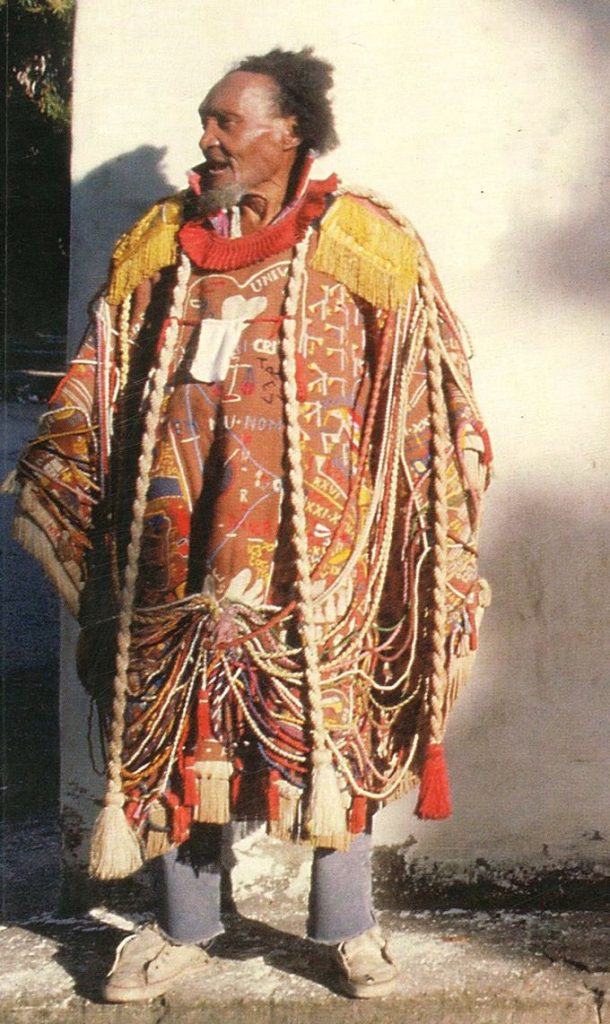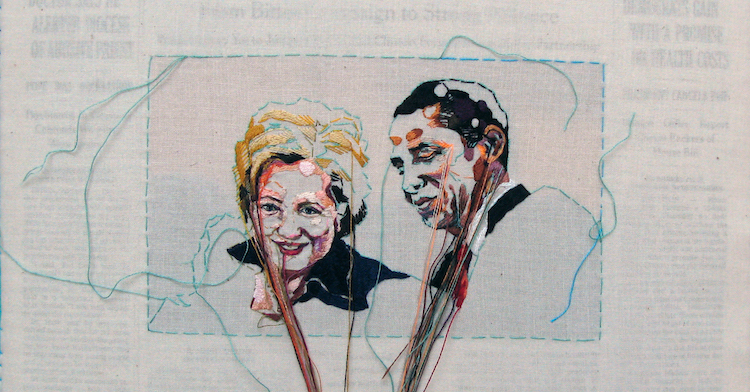Theatres are just starting to awaken from a year-long slumber during the pandemic, and I want to record my experience as a backstage runner during this once-in-a-lifetime event. For me stitch is the ultimate record of memories, because it takes time and thought, and embroideries are often done to commemorate a significant event. I explored several artists who use hand embroidery in different ways to tell a narrative or record thoughts to get inspiration for how I could use stitch as a record.
Richard McVetis
McVetis mostly works with data visualisation through stitch, however be also does stitch “doodles”. These doodles remind me a lot of the geometic lines and shapes of Wassily Kandinsky’s work, I like the idea of using stitching doodles to illustrate opera like I did with my watercolour and oil pastel compositions. What I like about doodles is that they are absent minded and you do them while you are daydreaming or having a thought process, and I want to use stitch to capture my thoughts while I am at work in the opera, even if they don’t depict anything I will remember where I was and what I was thinking about while I was stitching each section.
Arthur Bispo do Rosario

Arthur Bispo do Rosario had schizophrenia and lived in a psychiatric hospital for 50 years. He recorded everything in his life in stitch, with the intention of marking God’s passing on earth. His presentation cloak was a piece he intended to wear on Judgement Day, so God could understand who he was.
Bispo do Rosario recorded his everyday life, which is what I want to do with the opera project. He embroidered the cloak as a reflection on his life and experiences, and in a similar way I have a tail coat from the costume cupboard of a touring opera company which I plan to embroider with my experiences and thoughts.
Celia Pym

Celia Pym uses her work to engage with the history of a garment. The damage and wear of fabric and clothing over time tells it’s story, and she uses visible mending (mainly darning) to preserve the garment and enable it to tell it’s story.
I had a conversation with Vanessa Woodward of Opera Anywhere near the beginning of my project, talking about my ideas of recording my experience through stitch and fabric inspired by the costume element of opera. She mentioned that costumes in opera are used again and again, either in the same production or an entirely different context, and all costumes have labels in them with the names of previous wearers, and within the music industry singers will find they have a costume worn by a famous singer before they were even known. I really like the idea of the history of singers’ careers being held in the wear and labels of their costumes, and the jacket I acquired for this project is from Opera Anywhere’s wardrobe, and they know the person it previously belonged to. The jacket has holes in a few places, and I like the idea of using visible decorative mending on those areas to celebrate the performance history of the jacket.
Sashiko Mending

Sashiko is a Japanese mending technique that emerged from necessity, the poor couldn’t afford new clothes, so when clothing became worn, garments would be sewn together with a simple running stitch to create a new one. It was seen as shameful to own a sashiko garment, but over time the stitches became more decorative and stylish. In modern times it has been adopted by the slow fashion and sustainability movement to highlight the importance to mending and the beauty of repairing old garments.
I’m hoping to collect scraps of fabric from the costume department at Garsington Opera and applique them onto the jacket in a style inspired by sashiko. Incorporating the scraps into the piece will be my way of keeping a physical textural reminder of my experience, and celebrate all the different fabrics used in the productions this year.
Lauren DiCioccio

The first series of work Lauren DiCioccio exhibited was her “sewn-news” wall hangings, where she embroidered into news stories in the New York Times. The purpose of the embroidery was to show the passage of time and the idea the whole story could unravel if you pulled at one thread. She was first attracted to stitch because of the nostalgia that comes with it, everyone has a sewing anecdote, even if it is sewing on a button that fell off. I relate to this, I remember things when I repair them or sew the item, or where I was when I was doing it, and her sewing the news is a way of capturing the moment and immortalising the memory to look back on the things you thought were important at the time.
Rosalind Wyatt

What I like about Rosalind Wyatt’s work is how she stitches the stories of the people who owned them onto the garments, emphasising how clothing carries experiences, memories and stories. I like the idea of using garment to tell a story, the concept is central to my project, using bandannas and masks I made and wearing them to the opera, then stitching into them while I am there, and stitching into the costume. This draws particular parallels with the jacket, since I am stitching into a garment that has passed through several hands before mine, and I am stitching in my experience in general. The difference for me is that I am capturing my own memories for my future self to look back on.
Maurizio Anzeri

Using a combination of found vintage photographs and stitch, Anzeri aims to give the characters in the photos a new life in “photo-sculpture”. He says “The intimate human action of embroidery is a ritual of making and reshaping stories and history of these people.” I like how he uses geometric shapes to liberate the characters in the pictures, giving them a personality and encouraging the viewer to focus in specific places, such as the eyes.
His approach to storytelling through stitch is very abstract, and I love the use of the geometric patterns to tell the stories. The fact that the story isn’t literal, it is up for interpretation, is appealing to me, I could use geometric embroidered shapes and patterns on the jacket to tell the story of my experience in the theatre coming out of lockdown.

I want my project to be a sort of time capsule for this part of my life, so I can look back on it in ten years and remember where I was and what I was doing and thinking at the time I was stitching each part. For many people hand embroidery is a form of meditation, allowing their mind to wander and think in a deep way that you cannot do with many other hobbies. While I stitch I want to reflect on my experiences in lockdown, the opera and where I am at this point in my life, what my hopes for the future are and record them afterwards in a notebook. The stitching itself may not immediately tell the story to someone else, but when I look at the stitching I will have memories and thoughts attached to them.
The hand embroidery part of this project was particularly inspired by the Windrush project I participated in, listening to stories of many individual’s experiences, some talked about their experiences of growing up black in the UK, others about their experiences of being an immigrant to the UK. We stitched while they talked, incorporating words, phrases and poetry they shared, as well as depicting feelings, passions and interests into our individual embroideries. I realised the power of stitching and the memories it can hold.